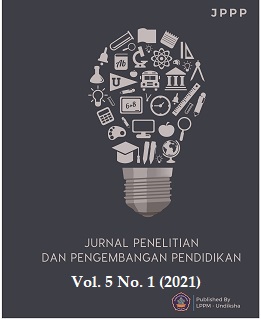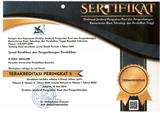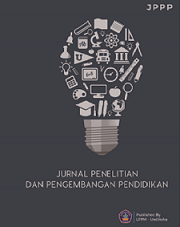Flipped Classroom Berbantuan Google Classroom Terhadap Hasil Belajar Matematika Berdasarkan Tingkat Computer Self-Efficacy
DOI:
https://doi.org/10.23887/jppp.v5i1.29737Keywords:
Flipped, Self-Efficacy, Google, MatematikaAbstract
Rendahnya hasil belajar matematika mahasiswa program studi sistem komputer disebabkan karena kurangnya penggunaan metode pembelajaran oleh dosen pengampu mata kuliah. Penelitian ini bertujuan untuk menyelidiki pengaruh flipped classroom berbantuan google classroom terhadap hasil belajar matematika ditinjau dari tingkat computer self-efficacy. Sehingga jenis penelitian yang digunakan yakni penelitian kuasi eksperimen dengan menggunakan rancangan Nonequivalent Control Groups Posttest-Only. Populasi dalam penelitian ini adalah mahasiswa program studi sistem komputer yang mengambil mata kuliah matematika. Sampel dipilih secara purposive random sampling dengan jumlah sampel sebanyak 190 mahasiswa program studi sistem computer yang dibagi dalam dua kelompok yakni kelompok eksperimen belajar dengan metode flipped classroom melalui google classroom, dan kelompok kontrol belajar secara konvensional. Data hasil belajar dikumpulkan dengan tes, sedangkan computer self-efficacy melalui kuesioner. Uji Anava dua jalur dan uji lanjut LSD digunakan dalam analisis data. Hasil menunjukkan bahwa tidak terdapat pengaruh interaktif antara metode perkuliahan dan tingkat computer self-efficacy terhadap hasil belajar matematika, p=0.643. Tingkat computer self-efficacy tidak berpengaruh terhadap hasil belajar matematika, p=0.190. Kelompok flipped classroom menunjukkan hasil belajar matematika lebih tinggi secara signifikan dibandingkan kelompok konvensional p=0.001. Dengan demikian, flipped classroom disarankan dalam upaya meningkatkan hasil belajar matematika.
References
Al-Zahrani, A. M. (2015). From passive to active: The impact of the flipped classroom through social learning platforms on higher education students’ creative thinking. British Journal of Educational Technology, 46(6), 1133–1148. https://doi.org/10.1111/bjet.12353.
Alkhatib, O. J. (2018). An interactive and blended learning model for engineering education. Journal of Computers in Education. https://doi.org/10.1007/s40692-018-0097-x.
Asarta, C. J., & Schmidt, J. R. (2020). The effects of online and blended experience on outcomes in a blended learning environment. The Internet and Higher Education, 44, 100708. https://doi.org/https://doi.org/10.1016/j.iheduc.2019.100708.
Bishop, J. L., & Verleger, M. A. (2013). The Flipped Classroom : A Survey of the Research The Flipped Classrom : A Survey of the Research. 120th ASEE Annual Conference & Exposition.
Bosch, C., Africa, S., Mentz, E., Africa, S., Reitsma, G. M., & Africa, S. (2019). Integrating Cooperative Learning into the Combined Blended Learning Design Model : Implications for Students ’ Intrinsic Motivation. 11(1), 58–73. https://doi.org/10.4018/IJMBL.2019010105.
Bösner, S., Pickert, J., & Stibane, T. (2015). Teaching differential diagnosis in primary care using an inverted classroom approach: student satisfaction and gain in skills and knowledge. BMC Medical Education, 15(1), 63. https://doi.org/10.1186/s12909-015-0346-x.
Brali, A., & Divjak, B. (2018). Integrating MOOCs in traditionally taught courses: achieving learning outcomes with blended learning. International Journal of Educational Technology in Higher Education, 15(2). https://doi.org/10.1186/s41239-017-0085-7.
Braun, I., Rittter, S., & Vasko, M. (2014). Inverted Classroom by Topic - A Study in Mathematics for Electrical Engineering Students. International Journal of Engineering Pedagogy (IJEP), 4(3), 11. https://doi.org/10.3991/ijep.v4i3.3299.
Caird, S., & Roy, R. (2019). Blended Learning and Sustainable Development. 1–10.
Clark, R. M., Kaw, A., & Besterfield-sacre, M. (2016). Comparing the Effectiveness of Blended , Semi-Flipped , and Flipped Formats in an Engineering Numerical Methods Course. Advances in Engineering Education, 1–38.
Dalshad, Z. (2019). The Underlying Factors of Computer Self-efficacy and the Relationship with Students’ Academic Achievement. International Journal of Research in Education and Science (IJRES), 5(1), 346–354.
DeLozier, S. J., & Rhodes, M. G. (2017). Flipped Classrooms: a Review of Key Ideas and Recommendations for Practice. Educational Psychology Review, 29(1), 141–151. https://doi.org/10.1007/s10648-015-9356-9.
Ferreira, J. M. M. (2014). Flipped classrooms: From concept to reality using Google Apps. Proceedings of 2014 11th International Conference on Remote Engineering and Virtual Instrumentation, REV 2014, February, 204–208. https://doi.org/10.1109/REV.2014.6784256.
Fonseca, K. A. B., & Peralta, F. S. (2019). Google Classroom : An Effective Virtual Platform to Teach Writing in an EFL Composition Course. International Journal of English Language Teaching, 6(1), 27–35. https://doi.org/10.5430/ijelt.v6n1p27.
Garrison, D. R., & Kanuka, H. (2004). Blended learning : Uncovering its transformative potential in higher education. Internet and Higher Education, 7, 95–105. https://doi.org/10.1016/j.iheduc.2004.02.001.
Gillette, C., Rudolph, M., Kimble, C., Rockich-Winston, N., Smith, L., & Broedel-Zaugg, K. (2018). A Meta-Analysis of Outcomes Comparing Flipped Classroom and Lecture. American Journal of Pharmaceutical Education, 82(5), 6898. https://doi.org/10.5688/ajpe6898.
Gillispie, V. (2016). Using the flipped classroom to bridge the gap to generation Y. Ochsner Journal, 16(1), 32–36.
Goodnough, K., & Murphy, E. (2017). The Professional Learning of Grade Six Teachers of Mathematics Implementing the Flipped Classroom Approach. Canadian Journal of Learning and Technology, 43(1), 1–20.
Guy, R., & Marquis, G. (2017). Flipped Classroom: A Comparison Of Student Performance Using Instructional Videos And Podcasts Versus The Lecture-Based Model Of Instruction. Issues in Informing Science and Information Technology, 13, 001–013. https://doi.org/10.28945/3461.
Hatlevik, O. E., Throndsen, I., Loi, M., & Gudmundsdottir, G. B. (2018). Students’ ICT self-efficacy and computer and information literacy: Determinants and relationships. Computers & Education, 118, 107–119. https://doi.org/10.1016/J.COMPEDU.2017.11.011.
Hertz, M. B. (2012). The Flipped Classroom: Pro and Con | Edutopia. Edutopia, 10–13.
Hughes, C. (2019). The Effects of Flipping an English for Academic Purposes Course. International Journal of Mobile and Blended Learning, 11(1), 26–41. https://doi.org/10.4018/IJMBL.2019010103.
Hwang, G.-J., Lai, C.-L., & Wang, S.-Y. (2015). Seamless flipped learning: a mobile technology-enhanced flipped classroom with effective learning strategies. Journal of Computers in Education, 2(4), 449–473. https://doi.org/10.1007/s40692-015-0043-0.
Jackson, C. R. (2018). Validating and Adapting the Motivated Strategies for Learning Questionnaire (MSLQ) for STEM Courses at an HBCU. AERA Open, 4(4), 233285841880934. https://doi.org/10.1177/2332858418809346.
Jakkaew, P., & Hemrungrote, S. (2017). The Use of UTAUT2 Model for Understanding Student Perceptions Using Google Classroom : A Case Study of Introduction to Information Technology Course.
Jones, N., Man, A., & Lau, S. (2010). Blending learning : widening participation in higher education. 47(4), 405–416. https://doi.org/10.1080/14703297.2010.518424.
Kashefi, H., Ismail, Z., Mohammad, Y., & Abdul, R. (2012). Supporting students mathematical thinking in the learning of two-variable functions through blended learning. 46(2004), 3689–3695. https://doi.org/10.1016/j.sbspro.2012.06.128.
King, D., Varsavsky, C., Belward, S., & Matthews, K. (2017). Investigating students ’ perceptions of graduate learning outcomes in mathematics. International Journal of Mathematical Education in Science and Technology, 48(S1), 67–80. https://doi.org/10.1080/0020739X.2017.1352044.
Li, S. (2015). Flip the classroom. Education for Primary Care, 26(6), 438–440. https://doi.org/10.1080/14739879.2015.1101854.
Lin, G.-Y. (2015). Self-Efficacy Beliefs and Their Sources in Undergraduate Computing Disciplines. Journal of Educational Computing Research, 53(4), 540–561. https://doi.org/10.1177/0735633115608440.
Lopes, A. P., & Soares, F. (2018). Perception and performance in a flipped Financial Mathematics classroom. The International Journal of Management Education, 16(1), 105–113. https://doi.org/10.1016/J.IJME.2018.01.001.
Lu, H., Hu, Y., Gao, J., & Kinshuk. (2016). The effects of computer self-efficacy, training satisfaction and test anxiety on attitude and performance in computerized adaptive testing. Computers & Education, 100, 45–55. https://doi.org/10.1016/J.COMPEDU.2016.04.012.
Mamaril, N. A., Usher, E. L., Li, C. R., Economy, D. R., & Kennedy, M. S. (2016). Measuring Undergraduate Students’ Engineering Self-Efficacy: A Validation Study. Journal of Engineering Education, 105(2), 366–395. https://doi.org/10.1002/jee.20121.
Matukhin, D., & Zhitkova, E. (2015). Implementing Blended Learning Technology in Higher Professional Education. Procedia - Social and Behavioral Sciences, 206(November), 183–188. https://doi.org/10.1016/j.sbspro.2015.10.051.
Maulan, S. B., & Ibrahim, R. (2012). The Teaching and Learning of English For Academic Purposes in Blended Environment (The 3rd International Conference on e-Learning ICEL 2011 , 23-24 November , Bandung , Indonesia). Procedia - Social and Behavioral Sciences, 67, 561–570. https://doi.org/10.1016/j.sbspro.2012.11.361.
Mehring, Jeffrey, & Leis, A. (2018). Innovations in Flipping the Language Classroom. In Jeff Mehring & A. Leis (Eds.), Innovations in Flipping the Language Classroom: Theories and Practices. Springer Singapore. https://doi.org/10.1007/978-981-10-6968-0.
O’Flaherty, J., & Phillips, C. (2015). The use of flipped classrooms in higher education: A scoping review. Internet and Higher Education, 25, 85–95. https://doi.org/10.1016/j.iheduc.2015.02.002.
Okaz, A. A. (2015). Integrating Blended Learning in Higher Education. Procedia - Social and Behavioral Sciences, 186, 600–603. https://doi.org/10.1016/j.sbspro.2015.04.086.
Prescott, E. (2017). Examining the Relationship Between Math Achievement and Self-Efficacy in Developmental Math Students. Walden University.
Radunovich, H. L., & Acharya, S. (2018). If You Flip It , Will They Watch ? Case Evaluation of a Hybrid Course. NACTA Journal, 62(March), 84–88.
Rohatgi, A., Scherer, R., & Hatlevik, O. E. (2016). The role of ICT self-efficacy for students’ ICT use and their achievement in a computer and information literacy test. Computers and Education. https://doi.org/10.1016/j.compedu.2016.08.001.
Slavin, R. E. (2018). Educational Psychology : theory and practice (12th ed.). Pearson.
Stajkovic, A. D., Bandura, A., Locke, E. A., Lee, D., & Sergent, K. (2018). Test of three conceptual models of influence of the big five personality traits and self-efficacy on academic performance: A meta-analytic path-analysis. Personality and Individual Differences, 120, 238–245. https://doi.org/https://doi.org/10.1016/j.paid.2017.08.014.
Strelan, P., Osborn, A., & Palmer, E. (2020). The flipped classroom: A meta-analysis of effects on student performance across disciplines and education levels. Educational Research Review, 30, 100314. https://doi.org/https://doi.org/10.1016/j.edurev.2020.100314.
Sun, Z., & Qiu, X. (2017). Developing a blended learning model in an EFL class’. Int. J. Cont. Engineering Education and Life-Long Learning, 27(Nos. 1/2), 4–21.
Talan, T., & Gulsecen, S. (2019). The Effect of A Flipped Classroom on Students’ Achievements, Academic Engagement and Satisfaction Levels. Turkish Online Journal of Distance Education, 20, 31–60. https://doi.org/10.17718/tojde.640503.
Torrisi-steele, G., & Drew, S. (2013). The literature landscape of blended learning in higher education : the need for better understanding of academic blended practice. International Journal for Academic Development, 18(4), 371–383. https://doi.org/10.1080/1360144X.2013.786720.
Wanner, T., & Palmer, E. (2015). Personalising learning: Exploring student and teacher perceptions about flexible learning and assessment in a flipped university course. Computers & Education, 88, 354–369. https://doi.org/10.1016/j.compedu.2015.07.008.
Wasserman, N. H., Quint, C., Norris, S. A., & Carr, T. (2017). Exploring Flipped Classroom Instruction in Calculus III. International Journal of Science and Mathematics Education, 15(3), 545–568. https://doi.org/10.1007/s10763-015-9704-8.
Wei, X., Cheng, I.-L., Chen, N.-S., Yang, X., Liu, Y., Dong, Y., Zhai, X., & Kinshuk. (2020). Effect of the flipped classroom on the mathematics performance of middle school students. Educational Technology Research and Development, 68(3), 1461–1484. https://doi.org/10.1007/s11423-020-09752-x.
Wolff, L.-C., & Chan, J. (2016). Erratum to: Flipped Classrooms for Legal Education. E1–E1. https://doi.org/10.1007/978-981-10-0479-7_8.
Downloads
Published
How to Cite
Issue
Section
License
Authors who publish with the Jurnal Penelitian dan Pengembangan Pendidikan agree to the following terms:
- Authors retain copyright and grant the journal the right of first publication with the work simultaneously licensed under a Creative Commons Attribution License (CC BY-SA 4.0) that allows others to share the work with an acknowledgment of the work's authorship and initial publication in this journal.
- Authors are able to enter into separate, additional contractual arrangements for the non-exclusive distribution of the journal's published version of the work (e.g., post it to an institutional repository or publish it in a book), with an acknowledgment of its initial publication in this journal.
- Authors are permitted and encouraged to post their work online (e.g., in institutional repositories or on their website) prior to and during the submission process, as it can lead to productive exchanges, as well as earlier and greater citation of published work. (See The Effect of Open Access)








